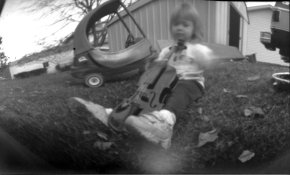goros
Member
Hi all,
I'm thinking in building my own pinhole camera out of a biscuit can and I have several questions about it.
My intention is not to use film, but paper (actually Ilford MGIV RC) therefore, getting a "paper negative". Afterwards, I will get a positive print by contact printing. If I place the negetive print on top of the second paper, emulsion to emulsion, I will get a positive copy but reverse sided (that is, left to right). A solution is to place the negative with the emulsion upwards, then printing through the negative paper. Is there any problem with this way?
Next question: As I will use a multigrade paper as "film", is there any advantage in using a contrast filter just behind the pinhole, to get a fixed contrast? How long a "standard" exposure would be?
Now building issues: Which pinhole size would be more or less OK? I will do it with a pin, so there will not be a lot of accuracy, just to get an idea: 1 mm, 2, 5?
And another one: Once the camera was built, is there any way to calculate the focal length of the hole?
Thinking about all these things, I have an idea that I don't know if it could be practical. The thing is to use a water lens. Just when the pinhole is open to take the exposure, put a small drop of water in the hole. If the exposure time is very long, the water will evaporate but for a exposure of five minutes it could work.
Well. too much for the first time.
Thanks in advance for your help.
Cheers
I'm thinking in building my own pinhole camera out of a biscuit can and I have several questions about it.
My intention is not to use film, but paper (actually Ilford MGIV RC) therefore, getting a "paper negative". Afterwards, I will get a positive print by contact printing. If I place the negetive print on top of the second paper, emulsion to emulsion, I will get a positive copy but reverse sided (that is, left to right). A solution is to place the negative with the emulsion upwards, then printing through the negative paper. Is there any problem with this way?
Next question: As I will use a multigrade paper as "film", is there any advantage in using a contrast filter just behind the pinhole, to get a fixed contrast? How long a "standard" exposure would be?
Now building issues: Which pinhole size would be more or less OK? I will do it with a pin, so there will not be a lot of accuracy, just to get an idea: 1 mm, 2, 5?
And another one: Once the camera was built, is there any way to calculate the focal length of the hole?
Thinking about all these things, I have an idea that I don't know if it could be practical. The thing is to use a water lens. Just when the pinhole is open to take the exposure, put a small drop of water in the hole. If the exposure time is very long, the water will evaporate but for a exposure of five minutes it could work.
Well. too much for the first time.
Thanks in advance for your help.
Cheers








 ) and enjoy it.
) and enjoy it.